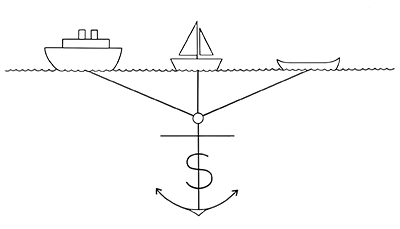
How: Charge a recurring fixed fee regardless of actual usage, time restrictions, features, or level of access.
Why: The simplicity of flat rate pricing is easy to communicate and therefore easy to sell in a complicated market.
In the Flat Rate business model, customers are able to purchase a product or service for a single, upfront payment and then utilize it to their heart’s content. This offers them the convenience of unrestricted consumption while also allowing them to maintain full control over their costs.
This model only remains financially viable for the business if the customers who exceed normal usage rates are balanced out by those who use the service sparingly. In some cases, companies may even need to impose upper limits on consumption in order to protect against exorbitant expenses. While this may go against the fundamental principle of unlimited use, it is sometimes necessary in order to ensure the transaction remains profitable.
Where did the Flat Rate business model pattern originate from?
The Flat Rate business model, also known as the “all you can eat” concept, was first popularized by Buckaroo Buffet in Las Vegas. Under this model, customers pay a fixed price to eat as much as they desire, regardless of their actual consumption. Prices are typically based on an average, with profits coming from the many customers who eat less than the average.
The history of the Flat Rate model is somewhat murky, but it is likely that it has been in existence for a very long time. One notable early adopter was the Swiss Federal Railways (SBB), which introduced an annual season ticket based on the Flat Rate concept in 1898. This ticket allowed passengers to travel unlimitedly by train in terms of time, train type, and route, for a fixed sum. Such arrangements appeal to frequent travelers and are financially viable due to the cross-subsidization of less frequent users. Annual tickets also provide a more stable and reliable revenue stream compared to the Pay Per Use model.
In the 1980s, the Flat Rate model was adopted by the tourism industry, with the term “all-inclusive” being used to describe package deals that include all meals and beverages during a vacation. One pioneer of this concept was Gordon Stewart, who opened the first all-inclusive hotel, Sandals Resorts, in Jamaica in 1981. His goal was to attract tourists who had been hesitant to visit the island due to political instability. Today, Sandals Resorts has made Stewart one of the most successful hoteliers in the Caribbean.
Applying the Flat Rate business model
The Flat Rate model can be an effective choice for businesses that meet one or more of the following criteria:
- Manageable costs: This model is particularly well-suited for businesses with low marginal costs, such as internet companies.
- Diminishing marginal utility: If customers’ desire for a product or service decreases with each additional unit they consume, the Flat Rate model can be a good fit.
- Cost-efficient billing: If it is more cost-effective for the business to bill customers a flat rate rather than charge per unit, the Flat Rate model may be the way to go.
Real life Flat Rate examples
Spotify
For a monthly flat fee, customers gain access to streaming all titles on the platform.
Basecamp
Contrary to its competition, the project management software service charges per account, not per user or project.
Telecommunications industry
In the 1990s, mobile telephony companies began offering Flat Rate plans that allowed customers to make unlimited calls within a predefined network for a fixed monthly price. These plans have now become commonplace and helped companies differentiate themselves in a newly deregulated market.
Netflix
Founded in 1999, Netflix is the first on-demand internet streaming media provider. For a monthly fee of $7.99, customers have unlimited access to over 100,000 films and TV shows. With over 26 million subscribers worldwide, Netflix’s Flat Rate model has been highly successful.
Trigger Questions
- How can a flat rate pricing model help you beat complex competing offerings?
- Will you be able to build an exponentially larger customer base in the long term if you charge a low flat fee?
- Is the typical customer still within the calculated profit margin?
- Are we willing to potentially sacrifice profits in order to increase market share and grow?
- How can we safeguard ourselves against customers taking advantage of our offer?
- Have we evaluated the price elasticity of demand?
- Have we considered the potential impact of losing price differentiation as a selling point?
Proven business models that have driven success for global leaders across industries. Rethink how your business can create, deliver, and capture value.
Get your deck!Related plays
- Business Model Navigator by Karolin Frankenberger and Oliver Gassmann
- What Is A Flat Rate Pricing Model? Pros & Cons Explained by Patrick Campbell

